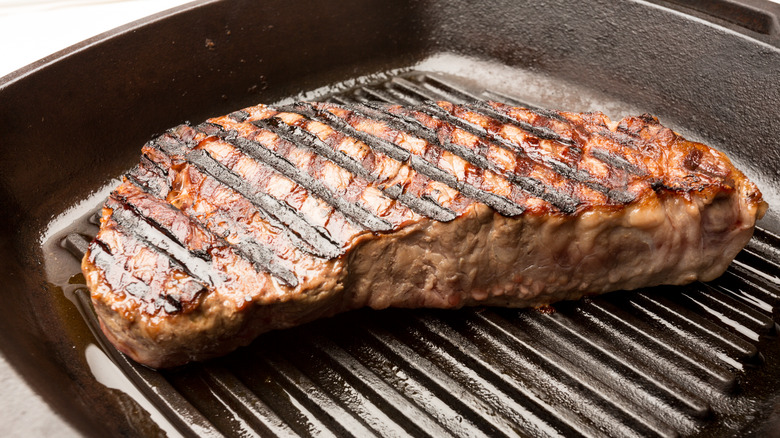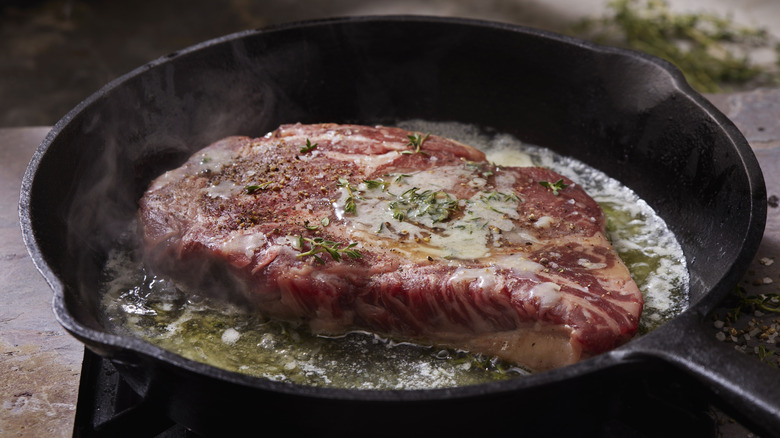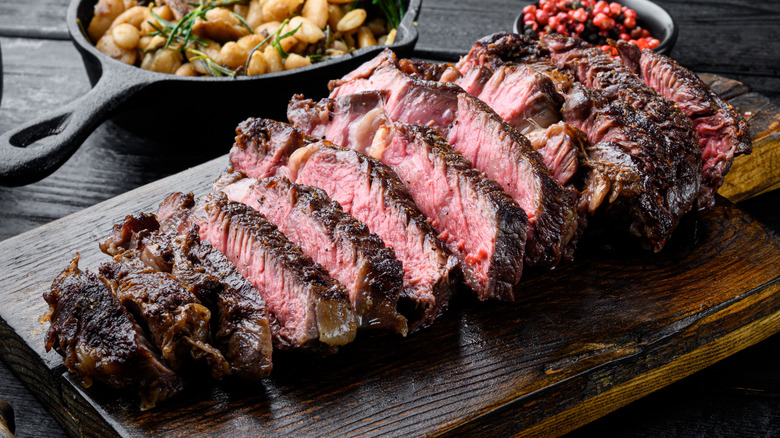What Is A Steak's Gray Band And How Do You Minimize It?
If you ask 10 cooks how to sear a steak, you will leave with 12 answers. Despite being a seemingly simple task, there are endless debates about how to make a steak. Fierce arguments have erupted at backyards, kitchens, and dinner tables over the virtues of a cast iron pan versus the grill, or the advantages of basting versus sous vide. From the temperature of the grill to the seasoning on the meat, there are endless opinions about how to cook a steak properly and avoid that notorious gray band, a sign of being overdone.
For steak aficionados, especially those among us who enjoy their beef on the rare side, the one thing that we can all agree on is that we want as little gray band as possible. The gray band refers to the fully cooked meat just below the crust of a seared or grilled steak and above the undercooked center that most steak enthusiasts enjoy. Most cooks accept it as part of the inevitable trade-off for a flavorful outer crust, but there is a way to minimize the gray band to create a better steak, and for that, you need to freeze the meat. The temperature difference helps protect the meat itself from overcooking.
Start with a frozen steak
One of the ways you can eliminate the dreaded gray band from your otherwise perfectly cooked steak is to start with a frozen one. Due to the temperature difference between the hot pan and the frozen meat, the heat cannot penetrate as deeply as it would in an unfrozen one, cooking as little of the interior as possible while the crust develops.
To prepare a steak in that manner, you need a thick steak — at least an inch and a half — such as a bone-in ribeye. You also need to make sure the steak is frozen flat with as little trapped moisture as possible, so place the steak without wrapping in a container before freezing. Minimizing the moisture is also a safety measure since a moist frozen steak will splatter in hot oil.
Once frozen, place it in a ripping hot cast iron skillet with a high-smoke point oil, and let the steak sear until a crust develops. Season it with salt and pepper — since seasonings do not adhere to frozen steaks – and place it in a low-temperature oven until the steak reaches your desired doneness. Let it rest for at least 10 minutes before carving, so to preserve its juiciness. For a touch of extra flavor, accompany the steak with compound butter.
Reverse your sear
Another method to minimize the gray band around your steak is to perform a so-called reverse sear, which might sound counterintuitive. The key to this method is to cook the steak in a controlled temperature environment using a sous vide machine, then sear the result to develop the crust. Since the sous vide method is designed to cook the ingredient evenly, your steak will have very little gray band when seared.
To reverse-sear a steak, place your steak (thawed this time) in a zipper bag with your favorite herbs, seasonings, and butter. Displace as much air as possible from the bag, seal it, and place it in a tub of water attached to an immersion circulator set to your desired doneness. Leave the steak in the water bath until the temperature is reached, then retrieve it from the bag. Pat it dry to prevent splatter and to shorten the searing time before searing it in a ripping hot cast iron skillet briefly for the crust to form.



